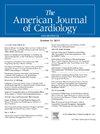经静脉心脏植入式电子装置植入术后三尖瓣反流恶化的发生率、时间过程和结果。
IF 2.1
3区 医学
Q2 CARDIAC & CARDIOVASCULAR SYSTEMS
引用次数: 0
摘要
有关经静脉心脏植入式电子装置(CIED)植入术后三尖瓣反流(TR)恶化的发生率、时间过程和预后的数据非常有限。我们筛选了 834 名首次接受经静脉 CIED 植入术的连续患者。在排除了没有进行术前或随访超声心动图检查的患者(361 人)和植入前有严重 TR 的患者(15 人)后,目前的研究对象包括 458 名患者。TR恶化的定义是新出现的中度或更严重的TR,或与基线相比至少增加了一个等级。在中位 2.1 年的随访期间,93 名患者(20%)出现了 TR 恶化。TR恶化的累积发生率在1年为10.2%,3年为18.6%。67名TR恶化的患者接受了超声心动图随访,其中不包括接受三尖瓣手术的患者,76%的患者TR严重程度有所改善,70%的患者无TR或TR程度轻微。在地标分析中,与1年内TR未恶化的患者相比,1年内TR恶化的患者5年内全因死亡和心衰住院的累积发生率明显更高(分别为24.8%对11.4%,P=0.002;35.2%对17.9%,P=0.002)。将恶化的TR作为时间依赖性协变量考虑时,在调整患者基线特征差异后,恶化的TR与全因死亡和心衰住院风险的增加显著相关(危险比[HR] 1.99,95% 置信区间[CI] 1.21-3.27,P=0.006;HR 2.64,95%CI 1.59-4.37,P=0.002)。本文章由计算机程序翻译,如有差异,请以英文原文为准。
Incidence, Time Course, and Outcomes of Worsening Tricuspid Regurgitation Following Transvenous Cardiac Implantable Electronic Device Implantation
Data regarding the incidence, time course, and outcomes of worsening tricuspid regurgitation (TR) after transvenous cardiac implantable electronic device (CIED) implantation are limited. We screened 834 consecutive patients who underwent first-time transvenous CIED implantation. After excluding patients without preoperative or follow-up echocardiography (n = 361) and patients with severe TR before implantation (n = 15), the present study population consisted of 458 patients. Worsening TR was defined as moderate or more TR that was newly developed or increased by at least 1 grade compared with baseline. During the median follow-up period of 2.1 years, worsening TR occurred in 93 patients (20%). The cumulative incidence of worsening TR was 10.2% at 1 year and 18.6% at 3 years. Of the 67 patients with worsening TR who underwent follow-up echocardiography, excluding those who underwent tricuspid valve surgery, 76% showed improvement in TR severity, with 70% having none or mild TR. On the landmark analysis, the 5-year cumulative incidence of all-cause death and heart failure hospitalization was significantly higher in patients with worsening TR at 1 year than those without worsening TR at 1 year (24.8% vs 11.4%, p = 0.002 and 35.2% vs 17.9%, p = 0.012, respectively). When considering worsening TR as a time-dependent covariate, worsening TR was significantly associated with an increased risk of all-cause death and heart failure hospitalization after adjustment for the differences in baseline patient characteristics (hazard ratio 1.99, 95% confidence interval 1.21 to 3.27, p = 0.006 and hazard ratio 2.64, 95% confidence interval 1.59 to 4.37, p <0.001, respectively). In conclusion, worsening TR after transvenous CIED implantation was not uncommon and had a dynamic nature with an improvement in the majority of patients, suggesting the functional etiology. Nonetheless, worsening TR was independently associated with an increased risk for mortality and heart failure hospitalization.
求助全文
通过发布文献求助,成功后即可免费获取论文全文。
去求助
来源期刊

American Journal of Cardiology
医学-心血管系统
CiteScore
4.00
自引率
3.60%
发文量
698
审稿时长
33 days
期刊介绍:
Published 24 times a year, The American Journal of Cardiology® is an independent journal designed for cardiovascular disease specialists and internists with a subspecialty in cardiology throughout the world. AJC is an independent, scientific, peer-reviewed journal of original articles that focus on the practical, clinical approach to the diagnosis and treatment of cardiovascular disease. AJC has one of the fastest acceptance to publication times in Cardiology. Features report on systemic hypertension, methodology, drugs, pacing, arrhythmia, preventive cardiology, congestive heart failure, valvular heart disease, congenital heart disease, and cardiomyopathy. Also included are editorials, readers'' comments, and symposia.
 求助内容:
求助内容: 应助结果提醒方式:
应助结果提醒方式:


